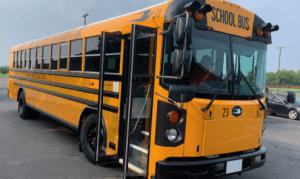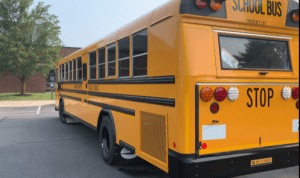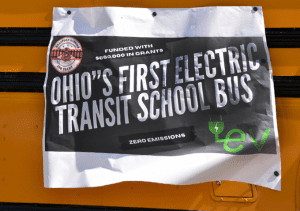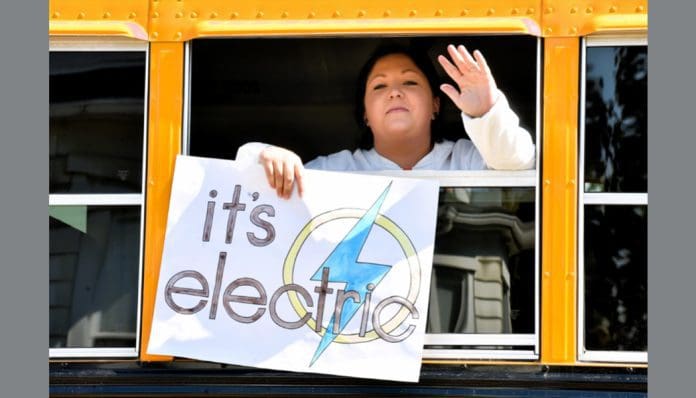A little over a year ago, Bradford Schools were going over their funding and looking for the money for a new bus. They ended up finding Grants to pay for new electric buses.
One grant was the EPA Clean School Bus Rebate Program. This offered school districts money to offset the electric school buses. Bradford was one of six districts in Ohio to receive the grant.
“With our small district and short routes, it seemed like the electric buses would work well,” Joe Hurst, Bradford Superintendent, said. “So we applied for it, we got the grant, that coupled with two other grants paid for two school buses and all the infrastructure at almost no cost to the district.”
 They currently have one electric bus and will get a second one in the spring. The electric buses will take over Bradford’s two routes.
They currently have one electric bus and will get a second one in the spring. The electric buses will take over Bradford’s two routes.
The cost difference in maintaining a regular bus versus an electric bus got the district’s attention. Looking at an estimated cost, a route for a regular bus costs roughly $17,00 a year for diesel. An electric bus doing the same route will cost approximately $116.
“We have only had the bus in service for a couple of weeks, so we haven’t really been able to compare the numbers ourselves,” Hurst said. “But even the numbers are close, we are still way ahead of what we were doing before, especially since we are getting two buses that were paid for mostly through grants.”
After knowing they would receive these buses, the district built a new bus barn beside the school to protect the new buses from the weather. After receiving a few more grants, they were able to put in charging stations.
“We put in a separate service out here that will operate nothing but the chargers, so we will be able to do a complete meter check to figure out exactly how much we are putting into those buses each month and make an accurate comparison to how much we were spending at the gas station before,” Hurst said.
An electric bus has about one-third fewer moving parts than a diesel bus. This means there is a lower expected maintenance cost as well. They have their mechanic and people on call if the bus breaks down.
“Our mechanic can do the little everyday things like changing a tire or if a light came on or a brake pad,” Chloe Thompson, Athletics and Transportation Director, said. “As far as the actual infrastructure or anything to do with the battery, he’s not trained in that, and I wouldn’t want to put him in that situation.”
 A fully charged electric bus will run 125 miles in perfect conditions. This is perfect for Bradford’s smaller district size and shorter bus routes.
A fully charged electric bus will run 125 miles in perfect conditions. This is perfect for Bradford’s smaller district size and shorter bus routes.
However, they have kept some diesel buses for longer trips the school may take.
“We travel too far for many of our athletic events,” Thompson said. “When you are driving that far and then sitting there for hours at a time. We could probably make it on a lot of them, but if we get in a pinch, we’re stuck. That’s why we keep those diesel ones around.”
The main reason for this is the lack of charging stations in the area. While there are quite a few charging stations around, none of them are fast chargers. A bus to fully charge on a regular charger would take several hours. Not to mention that many charging stations are made for smaller cars and don’t have room for a bus.
“We know the diesel buses will probably have to be there until they get the technology and the infrastructure big enough and available enough that we can plug in everywhere,” Hurst said.
Even though they have kept a couple of the diesel buses, they have also gotten rid of a couple.
“The diesel buses that the electrics are replacing are no longer in service,” Thompson said. “That was part of the deal because it’s through the EPA. They want to get those older models off the road.”
Being among the first to replace diesel buses with electric ones has gotten the district a lot of attention. They were asked to speak at a national coalition that met in Columbus. They got to talk about their experience and what the process looked like for them.
They met people from several states who were very interested in the process—giving the district exciting contacts.
“We get emails now from someone we met at that meeting, and they’ll say, hey, would you be interested in speaking at this conference coming up or sharing your story through this program,” Hurst said. “It’s new enough that people are taking an interest in it and trying to learn more from anyone who has been through it.”
Bradford is excited to be leading the pack in this way.
They hope to keep their momentum going and get an electric van soon for the district.
Bradford currently has a van that they bought with the intention of helping out with field trips and small pieces around the district. However, it has now evolved into a daily-use van, so it is no longer available for the tasks it was bought for.
“Since we have the infrastructure and everything set up out there, if we can get something that will last 100 miles to get to here and there to get around the district and the county, that would be wonderful,” Hurst said. “We’ve got a very good potential to get a new electric van.”
 The new electric buses bring excitement to the district not only for the financial impact but also for the environmental impact and the impact on students.
The new electric buses bring excitement to the district not only for the financial impact but also for the environmental impact and the impact on students.
“It’s nice to be able to do something for the environment and the world and know that we are doing something innovative enough to have the kids see how this impacts their community and air quality,” Hurst said. “Down the road, I’m hoping our science classes will be involved with how this affects smog and the environment and all the influences with that.”






